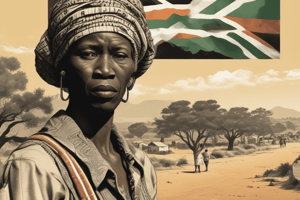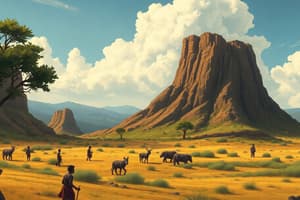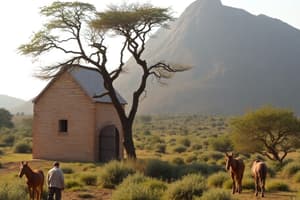Podcast
Questions and Answers
What was the main purpose of Plaatje's narrative?
What was the main purpose of Plaatje's narrative?
- To document successes of the South African Natives
- To describe the difficulties faced by South African Natives (correct)
- To entertain the reader with fictional stories
- To promote the laws of the Colonial Parliament
What method did Plaatje use to gather information about the Natives' Land Act?
What method did Plaatje use to gather information about the Natives' Land Act?
- He read books and articles about the law
- He conducted personal inquiries in various regions (correct)
- He interviewed members of the Colonial Parliament
- He created fictional accounts to illustrate his points
Who provided detailed accounts of the impacts of the Natives' Land Act?
Who provided detailed accounts of the impacts of the Natives' Land Act?
- Plaatje himself
- Local landowners
- Mr. Attorney Msimang (correct)
- The Colonial Parliament
How does Plaatje feel about the Colonial Parliament's actions?
How does Plaatje feel about the Colonial Parliament's actions?
What does Plaatje appeal to his readers for concerning the suffering of the natives?
What does Plaatje appeal to his readers for concerning the suffering of the natives?
What hypothetical scenario does Plaatje use to illustrate his argument?
What hypothetical scenario does Plaatje use to illustrate his argument?
What challenges did the natives face as highlighted by Plaatje?
What challenges did the natives face as highlighted by Plaatje?
What tone does Plaatje adopt towards the suffering of the natives?
What tone does Plaatje adopt towards the suffering of the natives?
What can be inferred about Plaatje's intended audience?
What can be inferred about Plaatje's intended audience?
What was the primary consequence of the formation of the Union of South Africa for the Native population?
What was the primary consequence of the formation of the Union of South Africa for the Native population?
How did the Natives' Land Act affect relations between white farmers and black tenants?
How did the Natives' Land Act affect relations between white farmers and black tenants?
What strategy did General Hertzog employ to gain political support?
What strategy did General Hertzog employ to gain political support?
What did General Botha's efforts reveal about his political stance?
What did General Botha's efforts reveal about his political stance?
What did the passage of the Natives' Land Act represent for the government?
What did the passage of the Natives' Land Act represent for the government?
What was a significant social outcome of the Natives' Land Act?
What was a significant social outcome of the Natives' Land Act?
Which of the following best describes the political climate surrounding the Natives' Land Act's passage?
Which of the following best describes the political climate surrounding the Natives' Land Act's passage?
What led to the compliance of Parliament with the racial extremists' demands?
What led to the compliance of Parliament with the racial extremists' demands?
How did the former British protections impact the Native population after the Union's formation?
How did the former British protections impact the Native population after the Union's formation?
What role did racism play in the political strategies of leaders like Hertzog?
What role did racism play in the political strategies of leaders like Hertzog?
What was one reason farmers in Bethal justified the use of violence against workers?
What was one reason farmers in Bethal justified the use of violence against workers?
What event prompted the potato boycott in the Bethal region?
What event prompted the potato boycott in the Bethal region?
Which of the following perspectives saw Black individuals as needing assistance from white individuals?
Which of the following perspectives saw Black individuals as needing assistance from white individuals?
How did farmers in Bethal generally respond to reports of violence against workers?
How did farmers in Bethal generally respond to reports of violence against workers?
What did Gogo Mshanelo's visions reveal regarding the dispossessed?
What did Gogo Mshanelo's visions reveal regarding the dispossessed?
What was a consequence of the violent treatment of farm workers?
What was a consequence of the violent treatment of farm workers?
What was discovered on Glenroy Farm in 2015?
What was discovered on Glenroy Farm in 2015?
How were the prisoners treated in death according to the findings?
How were the prisoners treated in death according to the findings?
What role did Gogo Nonhlan's spiritual visions play in the investigations?
What role did Gogo Nonhlan's spiritual visions play in the investigations?
What did forensic expert David Klatzow emphasize during his investigation?
What did forensic expert David Klatzow emphasize during his investigation?
Which of the following symbolizes Gogo Mshanelo's ability to unearth hidden truths?
Which of the following symbolizes Gogo Mshanelo's ability to unearth hidden truths?
What were the graves of the prisoners often considered to be?
What were the graves of the prisoners often considered to be?
How did some perceive Gogo Nonhlan's spiritual claims during the investigations?
How did some perceive Gogo Nonhlan's spiritual claims during the investigations?
What does the continued demand for freedom by the dead signify?
What does the continued demand for freedom by the dead signify?
What was a common historical practice related to the concealment of bodies?
What was a common historical practice related to the concealment of bodies?
What were the bones of the deceased designed to reveal?
What were the bones of the deceased designed to reveal?
What is a significant consequence of dispossession described in the context of the Kgobadi family?
What is a significant consequence of dispossession described in the context of the Kgobadi family?
How does the text describe the perspectives of white liberals and farmers regarding dispossession?
How does the text describe the perspectives of white liberals and farmers regarding dispossession?
What does the term 'ontological nowhereness' refer to in the context of dispossession?
What does the term 'ontological nowhereness' refer to in the context of dispossession?
What ethical and spiritual aspect does the text emphasize in understanding dispossession?
What ethical and spiritual aspect does the text emphasize in understanding dispossession?
What does the act of burying the deceased child in a 'stolen grave' symbolize?
What does the act of burying the deceased child in a 'stolen grave' symbolize?
Which of the following is a common theme regarding the treatment of Black workers in Bethal?
Which of the following is a common theme regarding the treatment of Black workers in Bethal?
What narrative element does the Kgobadi family's struggles represent?
What narrative element does the Kgobadi family's struggles represent?
In terms of historical perspective, why is it essential to view dispossession from multiple viewpoints?
In terms of historical perspective, why is it essential to view dispossession from multiple viewpoints?
What ongoing struggle do the dispossessed Black populations experience according to the text?
What ongoing struggle do the dispossessed Black populations experience according to the text?
Why is historical dispossession crucial to understand in the present context?
Why is historical dispossession crucial to understand in the present context?
Flashcards are hidden until you start studying
Study Notes
Plaatje's "Native Life in South Africa"
- Plaatje's book "Native Life in South Africa" aims to expose the hardships faced by South African natives under the 1913 Natives' Land Act.
- He utilizes personal observations and accounts from friends like Mr. Msimang to document the consequences of the Act.
- He highlights the eviction of black families from land, the disregard of their rights by the colonial government, and the lack of representation for native populations in Parliament.
- He criticizes the colonial government for its oppressive laws and draws parallels to hypothetical scenarios in London to illustrate the unfairness of the situation.
- He emphasizes the disruption of harmonious relations between black tenants and white farmers imposed by the Act.
- He details political opportunism by figures like General Hertzog and General Botha, who used the Act for racialized political gains.
- He argues that the passage of the Natives' Land Act represents a surrender to racial extremism and a denial of fundamental rights for black South Africans.
The Fight for Land and the Ghosts of Dispossession
- The text focuses on the ongoing impact of dispossession on black South Africans and how different perspectives, including those of white liberals, farmers, and the dispossessed, view and interpret this history.
- The Kgobadi family's story illustrates the devastating effects of eviction and the hardships faced by many black families.
- The text emphasizes the spiritual and ethical dimensions of dispossession, noting the trauma of losing land and the ongoing struggle for recognition and justice.
- The burial of the deceased child in a "stolen grave" illustrates the fear and desperation faced by those forced from their land.
- The discovery of 100 bodies on Glenroy farm, believed to be prison laborers, highlights the systemic violence and dehumanization prevalent in South Africa's history.
- The burial practices, characterized by unmarked graves and disregard for the dead, reflect a deep cultural and ethical violation.
- Gogo Mshanelo, through her spiritual visions, uncovers the buried history and challenges dominant interpretations of land dispossession.
- The text critiques the perspectives of white liberals and farmers, arguing that their understanding of dispossession is often superficial and misses the deeper spiritual and ethical implications.
- The text emphasizes the ongoing struggle for freedom and justice, even in death, as the spirits of the dispossessed demand recognition and liberation.
Forensic Investigation and the Hidden Truths of Dispossession
- Forensic investigations on Glenroy farm aim to reveal the extent of historical injustices, with bones serving as evidence of violence and suffering.
- The nameless and faceless nature of the dead bodies complicates efforts to notify families and achieve closure.
- Gogo Mshanelo’s spiritual visions complement the forensic investigation, highlighting the need to address the unseen trauma and injustices.
The Violence of South African Agriculture
- Media coverage of farm killings in Bethal sparked social outrage, but the violence was often dismissed or downplayed by authorities and farmers.
- Farmers justified their violent actions by portraying workers as inherently "criminal" and "childlike" who required harsh control.
- The case of Cornelius Mokgoko, beaten to death for being slow, highlights the systemic violence inherent in the agricultural system.
- The potato boycott, sparked by Cornelius's death, signaled a growing awareness of the abuses endured by farm labourers and the need for political action.
The Ethical and Eschatological Dimensions of Dispossession
- The text explores how different perspectives shape our understanding of dispossession, emphasizing the importance of ethical and eschatological perspectives.
- Liberals, like De Beer and Van Wyk, often viewed black people as needing white aid, demonstrating the inherent misrecognition of their struggles.
- The text argues that both the paternalistic altruism of white liberals and the brutal violence of farmers misrepresent the true suffering of the dispossessed.
- The spiritual perspective, embodied by Gogo Mshanelo's visions, reveals the ongoing suffering of the dispossessed and their demand for freedom and recognition.
The Concealed Suffering in a Beautiful Landscape
- The text highlights the inherent conflict and violence in South Africa's agricultural system, arguing that the beauty of the land conceals the underlying suffering of the dispossessed.
- The dispossessed lacked a sense of belonging and a place to die, their identity and humanity undermined by the system.
- The fear of white minority farmers towards black workers reflects the ongoing tensions and historical struggles embedded in South African land ownership.
Studying That Suits You
Use AI to generate personalized quizzes and flashcards to suit your learning preferences.




